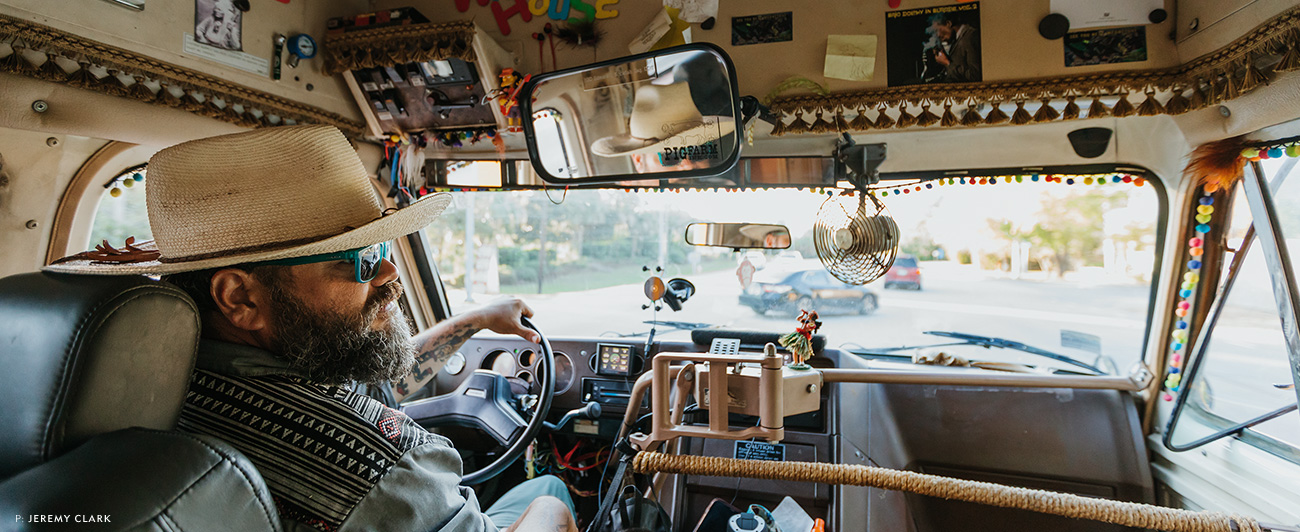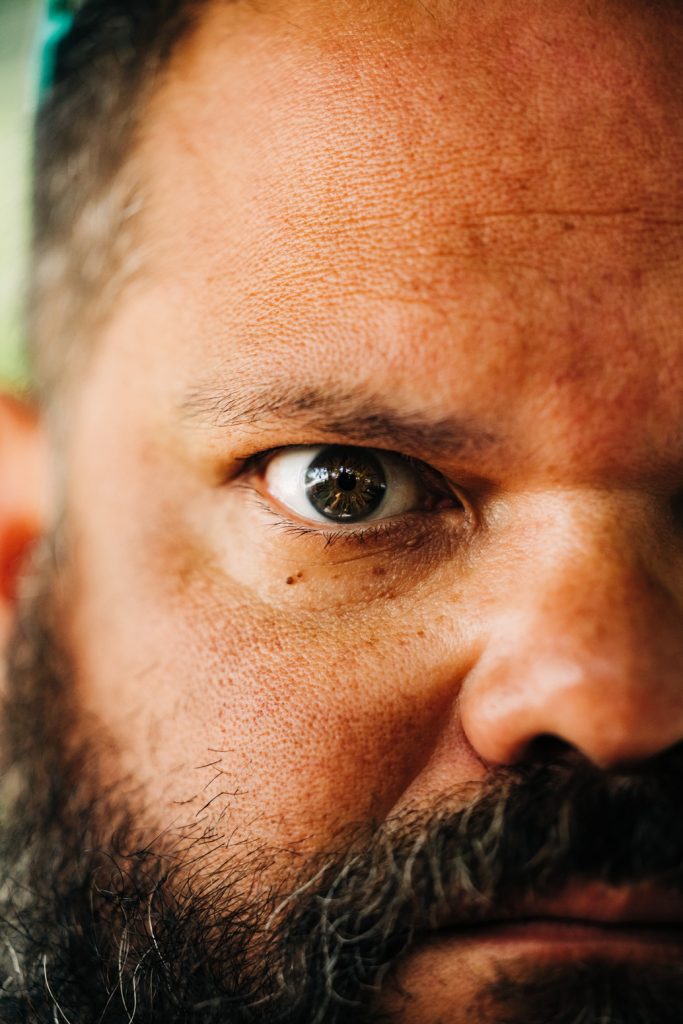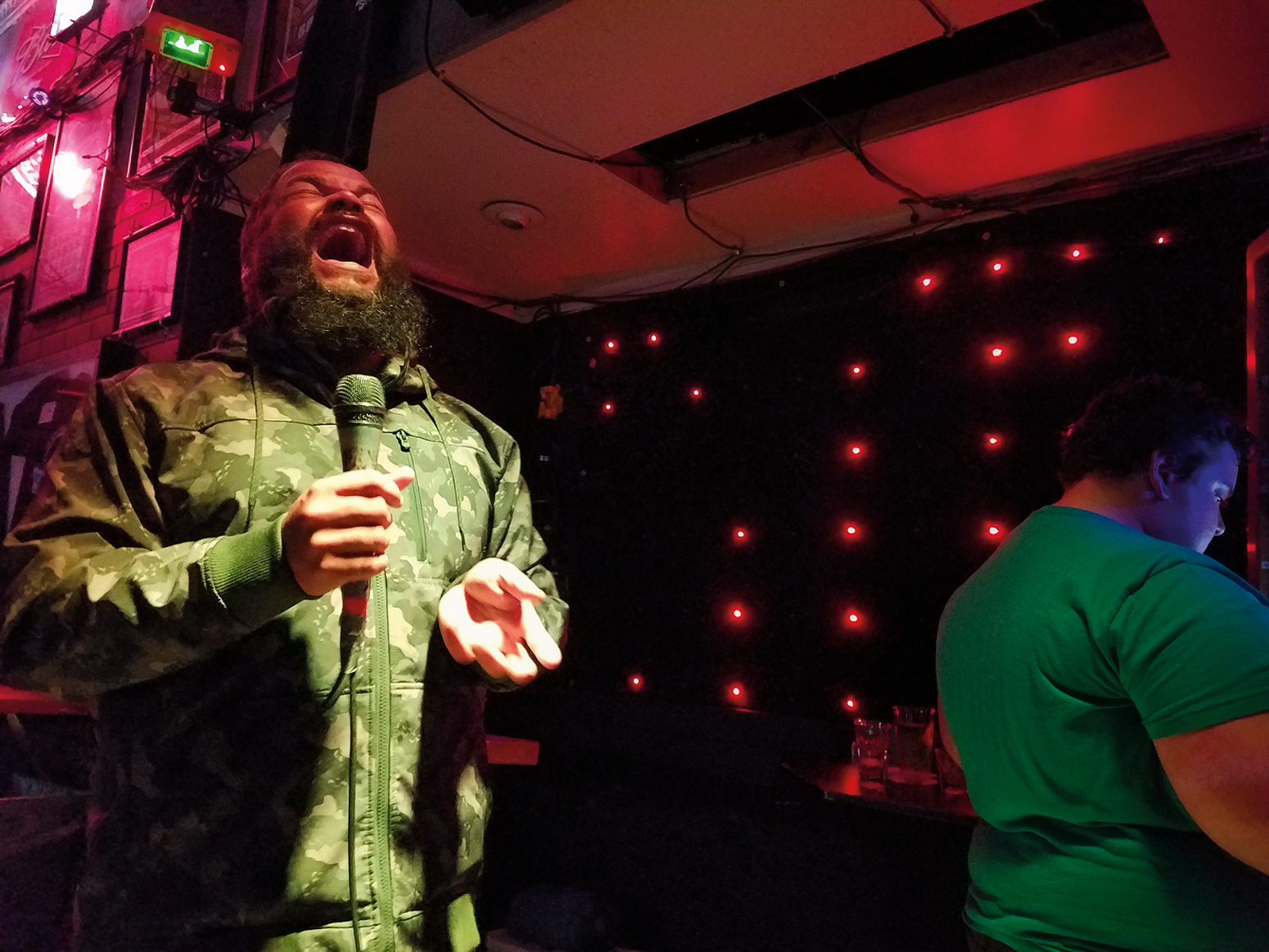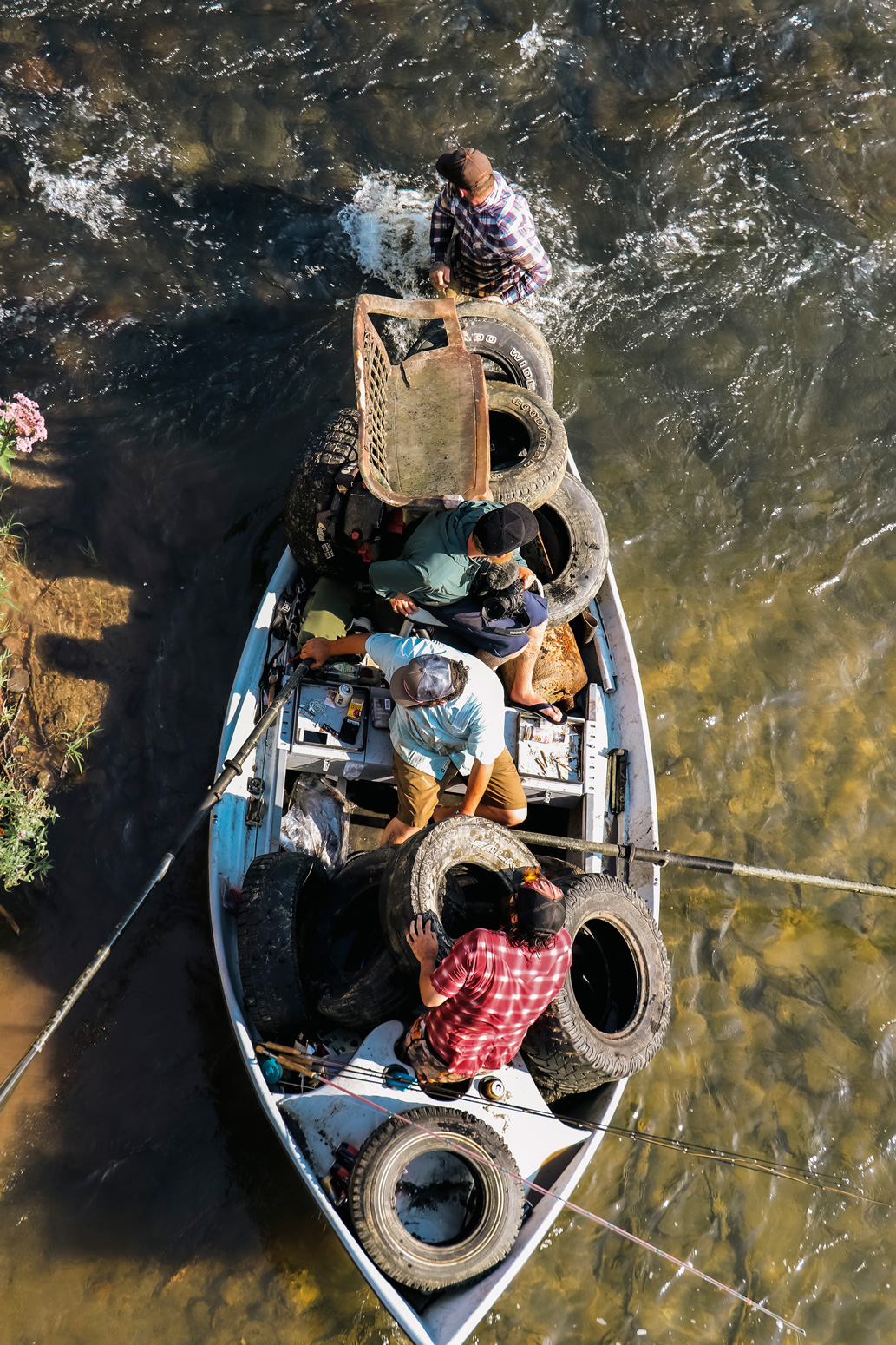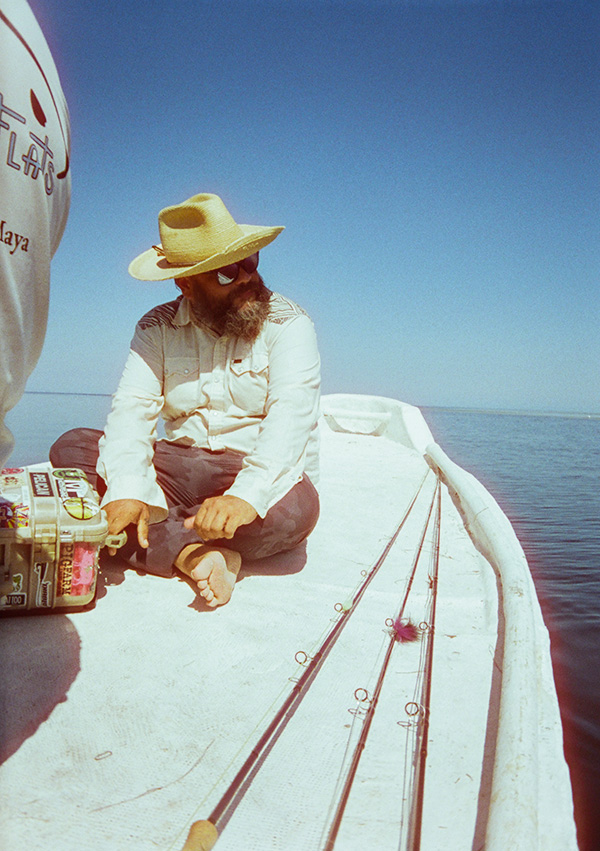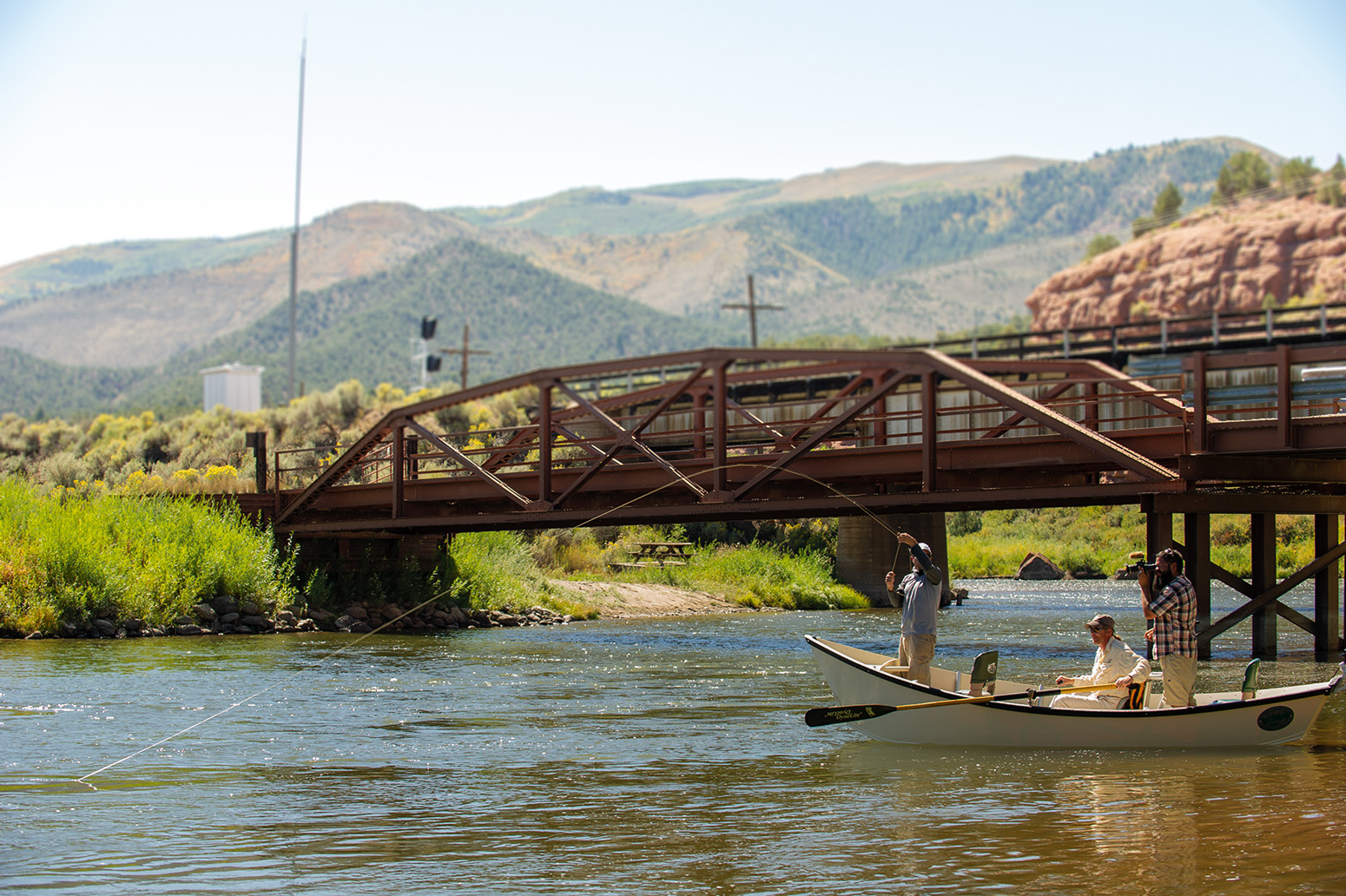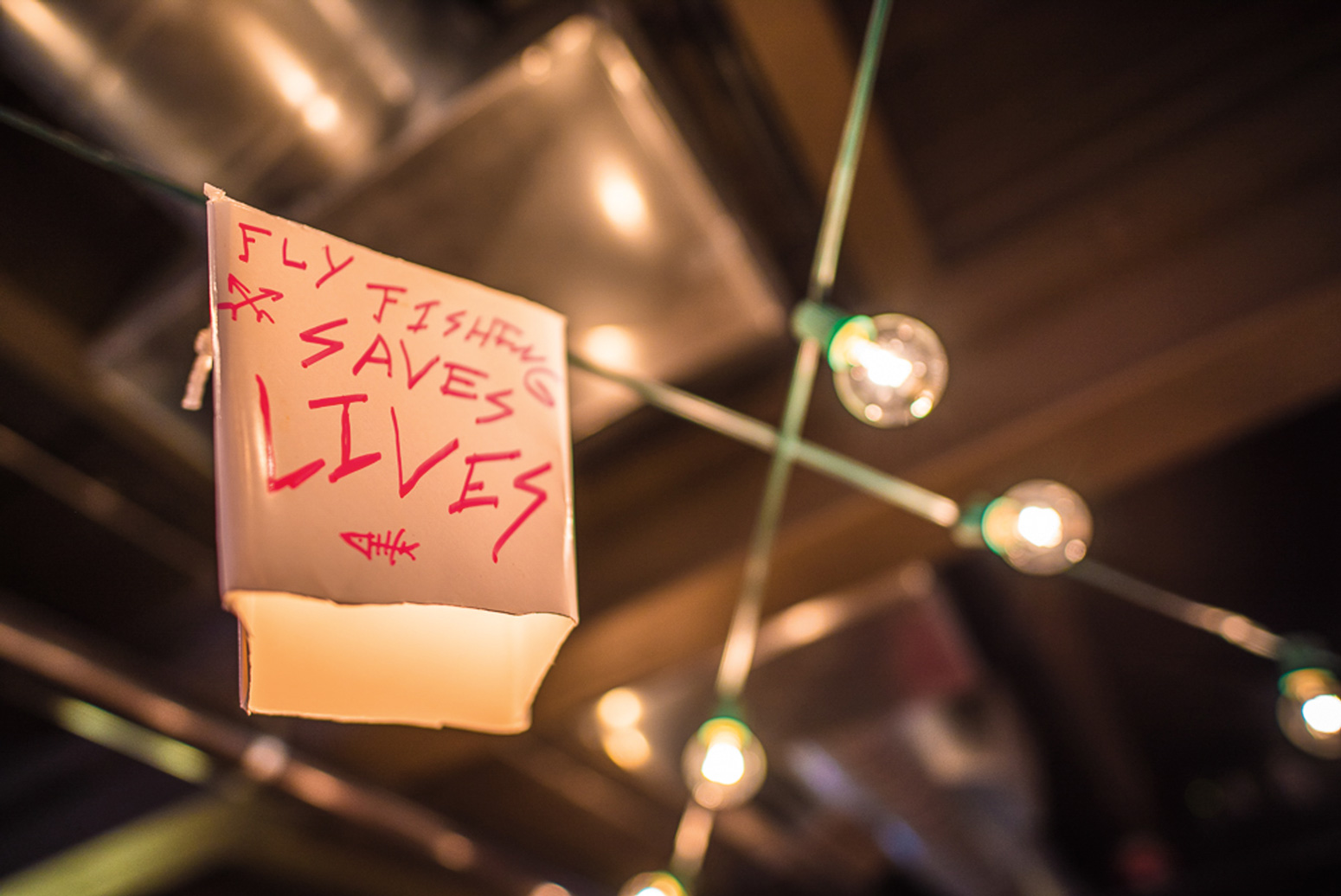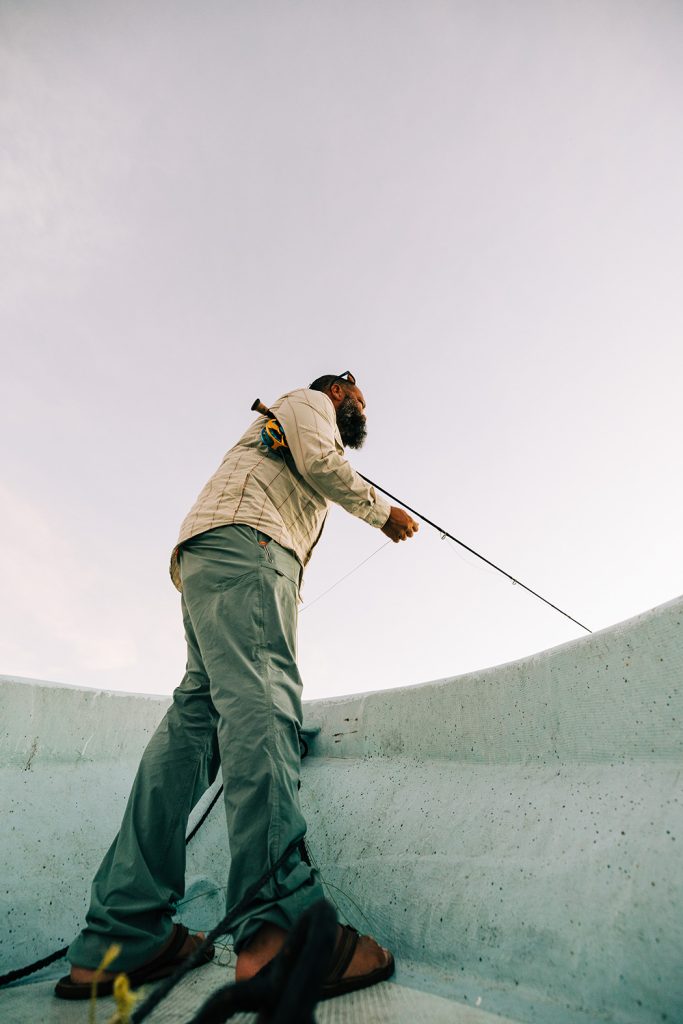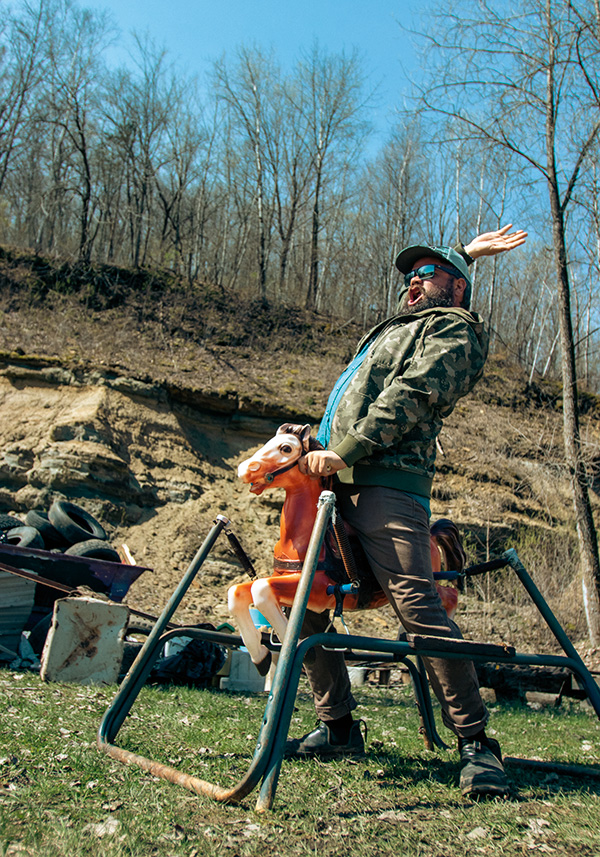Profile
Jay Johnson
EVERYBODY LOVES JAY: How Jay Johnson Plans to Save the World
First published in Volume 15, Issue 2 of The Flyfish Journal
above Jay Johnson attempts to break the camera with his Filipino/Jedi superpowers during a trip to Mexico’s Yucatán Peninsula in 2022. Fortunately he failed, a rarity for Johnson. Photo: Justin Carfagnini
We were supposed to be sleeping inside the offices of Bajío Sunglasses in New Smyrna Beach, but Jay couldn’t find the key when we returned from Merk’s Bar at 2 a.m. after fishing dock lights past the south causeway. Earlier, he’d picked me up at the airport after pulling his boat from Texas on the heels of two weeks fishing redfish. There aren’t many gaps in Jay’s stream of constant activity. He’s optimized to run this way. The next day I mentioned that I’d like to change clothes before going out for dinner and he said, “I don’t wear fishing clothes that I wouldn’t wear to dinner.”
Jay currently works at Bajío—in marketing, for lack of a better term. The goal is to sell sunglasses, of course, but Bajío wants to do this by getting “young people adventuring in the outdoors.” And according to Jay, selling sunglasses is just a way to “fund good and cool shit” like conservation projects, community programs and getting even more young people outside. Bajío founder Al Perkinson told Jay, “Build a rig. Travel the country. Spread the word.” So he bought a 40-year-old lifted 4×4 short bus from the Colorado mountains that used to take 14 kids to school through the snow. He gutted it and installed a sofa bed, a fridge, a bar with a solid hardwood top, a solar array, a new engine, a new transmission, a sound system, more stickers than I’ve ever seen in one place, and plenty of interior fringe so tassels will dance around the tops of the windows in the breeze when you cruise down the beach. Casey Anderson, a tattoo artist and fishing guide from Nevada, covered the bus with black-line illustrations. Jay also remodeled a 16-foot panga and installed a rear bumper rack on the bus where his Kawasaki KLR650 dual-sport motorcycle lives. You can watch all of this come together on Bajío’s Youtube series, Fishing with Jay.
Jay buzzes with generous, warm energy, and he spins enough chaos to keep you on your toes. As he says, “You have to keep it rowdy.” He makes people around him feel important. He’s genuinely interested in you. He’ll hype up the group of college students at the boat ramp who are camping in Mosquito Lagoon for the weekend. He’ll hype up the guys in the parking lot at the sushi place who ask about the bus. At one point he told me, “This isn’t fair. I’m doing all the talking. I want to know what’s up with you, too.”
Jay had a career as a professional musician but hasn’t played in years. He was a professional cartoonist for a hot minute, but only sketches camper bus plans now. He ran the oldest certified organic farm in Colorado for a few years and was working on breeding the “perfect sheep,” but has stepped away as the farm’s mission changed. He’s in the conversation for most well-traveled fly angler alive today and only has one fishing goal left: to catch a fish in Antarctica. He had a few different opportunities to make a career in mainstream television production but could never justify the compromises intrinsic to that industry. Jay is a principled man. These days he’s focusing everything he’s got on helping people. Usually through flyfishing.
“I don’t drink Mountain Dew,” he said.
“Evan Williams? Sure. That’s the bourbon of the people.”
above During a Pig Farm Ink Bitchin’ Tour stop in 2017 at Minneapolis’ Otter Saloon, Johnson displayed his soulful singing chops during a fly-tying/karaoke event, aptly named American Flydol. Photo: Justin Carfagnini
Jay’s dad was a tall Swede from Minnesota who moved to Oregon as a kid and dropped out of high school during 10th grade to work in the woods. About a year later he went back to watch a basketball game with some friends who were still in school. They were drunk and snuck Rainier stubbies into the bleachers and made a scene and started a fight and got arrested. All the kids that were still in school had to pay a fine, but Jay’s dad got two weeks in jail. When he got out, he went straight to the judge’s house and blasted the hinges off the front door with a 12 gauge and killed his two dogs. Then he enlisted in the Navy. He did nine tours in Vietnam in a forward air control group and saw some shit. He met Jay’s mom when he was living in the Philippines between deployments.
They ended up in Cheyenne, WY, after the war and Jay’s mom didn’t adapt well. She had never lived anywhere but the Philippines. She became hooked on pills during a bad bout of kidney stones and went off the rails. Jay and his sisters watched as their dad tried to kill her and then watched their dad wrestle a gun away from the cops that came. They fled to Texas with their mom and their dad went to jail, but they found themselves back with him in southwest Washington state a few years later.
Jay’s dad would leave $2 in the kitchen every morning before he disappeared for the day cutting firewood and wrestling professionally in Portland, OR, with Roddy Toombs, better known as “Rowdy” Roddy Piper. They didn’t have running water, electricity or a phone, but they had a generator they’d fire up to watch movies on the weekends. One day a neighbor called Adult & Family Services and Jay and his sisters were placed in a group home. Jay says this was when he realized that other kids slept in beds every night. He describes his childhood as “growing up tough.” He credits his upbringing with fostering his appreciation for the outdoors—there wasn’t anything else to do as a kid but mess around in the creek behind his house. He says he wouldn’t change his childhood. It made him who he is today.
above Get Trashed on the Delaware River, 2017. Jay Johnson, Nick Hall, Casey Anderson and Jonathan Jones navigate an overloaded drift boat to the grassy takeout. The load was too heavy for the borrowed tour van of Wyoming band Teenage Bottlerocket, which promptly got stuck in the mud. They were a bit late to the after party. Photo: Justin Carfagnini
In high school Jay discovered music and learned to play bass. During his junior year, he was recruited by Julliard. Starting with high school trips to Europe, Jay toured the world playing jazz. He studied at Mt. Hood Community College, renowned for its jazz festival. He says the jazz ensemble was “treated like the Beatles” in Japan because jazz is lauded as the quintessential American art form there. China was cool but they couldn’t get drunk on their 3.5 percent beer. And he says Korea was wild—they held hands with strangers at crosswalks.
Between tours Jay fish-bummed around the Pacific Northwest, living out of his 4Runner, making money winning karaoke contests. He was way into flyfishing, but says his local shop treated him like shit for months. “They watched me like a hawk every time I went in the store. They thought I was going to steal something,” Jay says. He was good at catching carp on dry flies and Tim Rajeff noticed. Rajeff had just started Echo Fly Rods and Jay talked his way into a job there, but Rajeff told him to fish as much as possible because he couldn’t afford to take him on full time.
Jay was the third-darkest kid in his hometown and was bullied by the kids that liked country music, so he never engaged with it until his foster dad turned him onto Hank Williams. Eventually, Jay joined an outlaw country band in Portland called Power of Country. Brian Jill, at the time a member of the Angling Exploration Group (AEG), reached out to Jay on Myspace to see if they could use some of the band’s music for a film they were working on. Power of Country was in Austin, TX, to play South by Southwest, and Jay and Brian met up there. They talked more about fishing than music and Jay started working with AEG after that.
Power of Country had an opportunity to go on tour opening for Hank Williams III. It was a big deal to Jay’s foster dad. Rajeff told Jay he’d be fired if he didn’t do it. So he turned down an AEG trip and went on tour with Hank III instead. He describes the tour as a “complete shitshow.” He says he saw a pound of cocaine disappear one line at a time over the course of a few hours one night. “It was a pile of cocaine bigger than all the cocaine I had ever seen in my life put together,” he says. There were a lot of fistfights. David Allen Coe’s son Tyler joined the tour, which only ratcheted up the chaos. Jay liked to party, but not like this. He found himself taking care of people, worrying about them constantly. When his AEG friends returned from Mongolia and showed him footage that would become Fish Bum I: Mongolia Riverwolf, he decided to quit music and jump into flyfishing full time.
above Johnson sits on the deck of a panga in the Yucatán searching for either rolling tarpon or a place to hang his hammock—or maybe both.Photo: Justin Carfagnini
AEG was a driving force behind what might be called a new flyfishing narrative of the early 2000s. Movies such as the Trout Bum Diaries and the Fish Bum series romanticized bad roads, broken trucks, sleeping in the dirt and, of course, flyfishing for big fish in exotic locations, all DIY on a small budget. Jay describes this shift as a reaction to the instructional and competitive style of the 1980s and ’90s, a turn toward more experiential and lifestyle-oriented storytelling.
This shift was inspired by the surf, skate, snowboard and skiing cultures that developed during the ’70s, ’80s and ’90s. Jay loved watching skateboard videos as a kid and would go outside and try the tricks himself. He was never very good at skateboarding, but he insists that movies about a thing should inspire you to do that thing. They should not be just for watching.
With AEG’s success came challenges. A dispute over the “Trout Bum” name posed some difficulties, so the crew started the Fish Bum series in response. Metalhead, the second (and final) of the Fish Bum films, “actually got big investors,” according to Jay. These investors also bought the Fly Fishing Film Tour, but they rubbed Jay and the AEG guys the wrong way—so Jay and AEG quit. They lost the rights to AEG content, were unable to work on other projects due to a non-compete agreement, and were sued by the investors. But they didn’t care. Though the money would have been good, it wasn’t the right partnership.
above Johnson in his natural element: on a boat, fishing, with a camera stuck to his face while Dave Tepper and Andy Toohey navigate the infamous dry fly slick at the Two Bridges put-in on the upper Colorado River, CO. Photo: Tim Romano
Through a convoluted series of events, Jay ended up editing Metalhead and the movie was well-received. Costa Sunglasses and Patagonia offered to sponsor a new venture, whatever the guys—at this point Jay, Thad Robinson, Brian Jill and Chris Owen—wanted to do. When they were no longer bound by their non-compete, they founded a new production company, Motiv Fishing. Their first film was Geofish, in which they convert a 7.3 liter Ford F-250 diesel to run on used vegetable oil and use it to fish their way through remote destinations in Mexico.
Geofish got the attention of National Geographic, who wanted to produce a flyfishing show for television but the money wasn’t right and the negotiations were slow. In the meantime, Motiv partnered with Bassmaster to make GeoBass. GeoBass featured Jay, Thad, Brian and Chris traveling the world in search of exotic bass species. In addition to Costa Sunglasses, several mainstream sponsors signed on, including Carhartt, Evan Williams and Budweiser. Mountain Dew was a sponsor for a short time, until Jay refused to drink it on camera. “I don’t drink Mountain Dew,” he says. “Evan Williams? Sure. That’s the bourbon of the people.” GeoBass premiered on a jumbotron at the 2014 Bassmaster Elite Series opener in Bainbridge, GA.
During the production of GeoBass, Jay received an email that read: “My name is Brad Johnson. I’m a big deal. Google me. I want to make a TV show with you.” Jay’s immediate reaction was, “Fuck this guy. Delete.” But it turns out that Brad Johnson really is a big deal. He developed, wrote and produced shows such as Coach, Clueless, and Arrested Development. He had been the head of the comedy department at 20th Century Fox and senior vice president of comedy development at Country Music Television. He was running a company called Watson Pond Productions with his son—both huge flyfishermen—and they wanted to make a flyfishing show.
Duck Dynasty was the biggest reality show on television at the time, so Johnson got the Motiv crew a test gig to see if they could work with Duck Dynasty’s production company. Jay describes the experience as surreal. He was working with professional production crews, people who had won Emmys, who had worked in television production for their entire careers—and Jay was earning more money than he had ever made by a wide margin. The show was supposed to be about blue-water competition fishing, but that’s not why it didn’t work. Jay quit after barely finishing the second episode because the direction was to create “drama that wasn’t there” to make the show interesting. It was fake, and Jay hated it.
He’s shopping for a sailboat that’s big enough to sail across oceans so he can meet all the kids that were named after him in remote corners of the world; he’ll bring them “the things they really need, like machetes, pencils, paper, books, iPads and Coca Cola.”
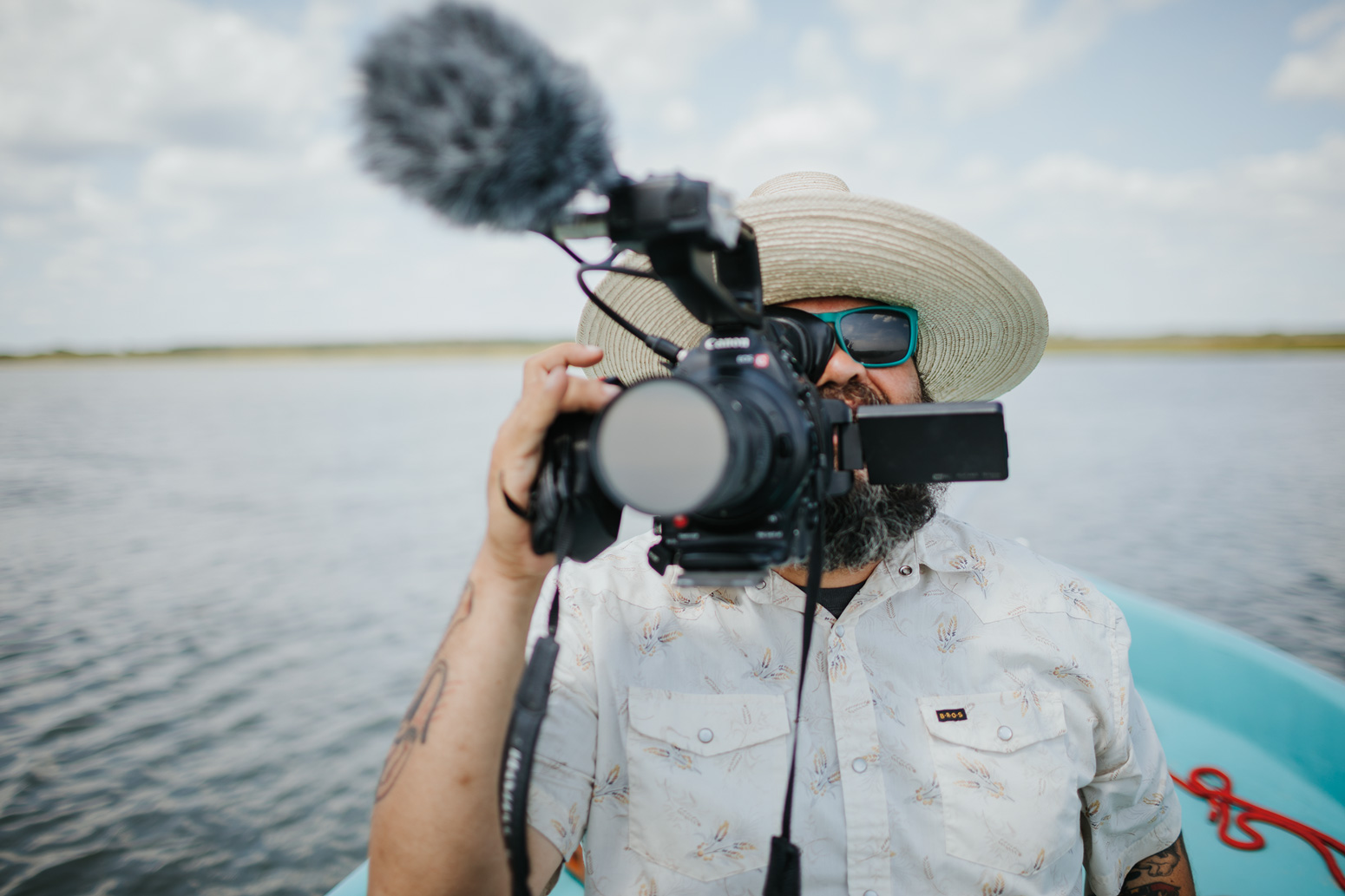
above Johnson doing one of the things he does best while chasing tailing redfish in Charleston, SC. Photo: Jeremy Clark
Soon thereafter, Motiv created Fish or Die, wherein the crew travels to the most remote areas of the world to catch exotic fish, all while facing some type of peril—for example, drug labs and hippos. After filming the pilot, Jay traveled to Nepal, where he was fishing for mahseer and working to build a school for formerly trafficked Dalit sex workers that would be funded by commercial fly tying. Thad called with some news: Animal Planet wanted to buy Fish or Die. Jay struggled with the decision because he felt it would take him further away from the work he was doing, but in the end he conceded. The profile and the money could amplify his ability to help others.
The crucible of hard work in hard places with local people has forged vital relationships and an important perspective for Jay. He said it can take an entire village to transport gear through the mountains and there is always at least one old guy who is the most badass of them all, an “absolute machine,” who carries more things farther than any of the young people. Their advice was always the same: Never stop. Jay offers his own advice: Always carry bags. Always help. Never walk over the mountain empty handed.
Jay wanted Fish or Die to focus more on these people, the locals who made it possible for him to reach remote areas, to survive in them, and to catch fish there. He had watched it play out before: If you teach the locals a little about being an outfitter and a little about flyfishing, they can create for themselves a sustainable source of life-changing income. Motiv’s work brought significant exposure to these places and people, places where wealthy westerners would want to fish. In the end, the network wanted the show to focus on the four anglers, so they opted to call it quits after the first season.
above The first Iron Fly events were so charged with positive Pig Farm energy that it could have been easy to miss one of the core messages: “Fly Fishing Saves Lives.” For “Farmers,” this wasn’t hyperbolic—it was a deep-seated belief borne from experience. Photo: Russ Schnitzer
I was tagging along on Jay’s first trip to the Bajío offices in a while. Perkinson was catching up with him. “We had to get a storage unit for all your stuff,” Perkinson told him. “You and Casey left quite a trail of shit last time you were here. That’s where your kayaks are, your crab traps, some other stuff. Also, hey, are there any firearms in that closet?” Turns out there were, but they were secured and there was no ammunition with them.
Jay and Perkinson have been working together for more than 15 years. Perkinson was the vice president of marketing at Costa Sunglasses when they sponsored GeoFish, GeoBass and several of Pig Farm Ink’s projects. Jay describes him as a visionary, a brother and someone who’s believed in him more than anyone else. Perkinson describes Jay as leading with his heart and as someone who puts good out in the world. Jay interrupts, saying “I think I lead with my good looks, but thanks anyway.”
The two are in agreement about a core belief that drives Bajío’s vision. As Jay puts it, “Old, rich white dudes are covered. But there are millions of kids out there that don’t even know that fishing and the outdoors are an option for them.”
How do we expose young people to a healthy activity that creates purpose and meaning and generates empathy and awareness? How do we help marginalized communities around the world and protect shallow-water resources for generations to come? Jay began the process of finding an answer to those questions over 10 years ago, an answer that would result in Pig Farm Ink.
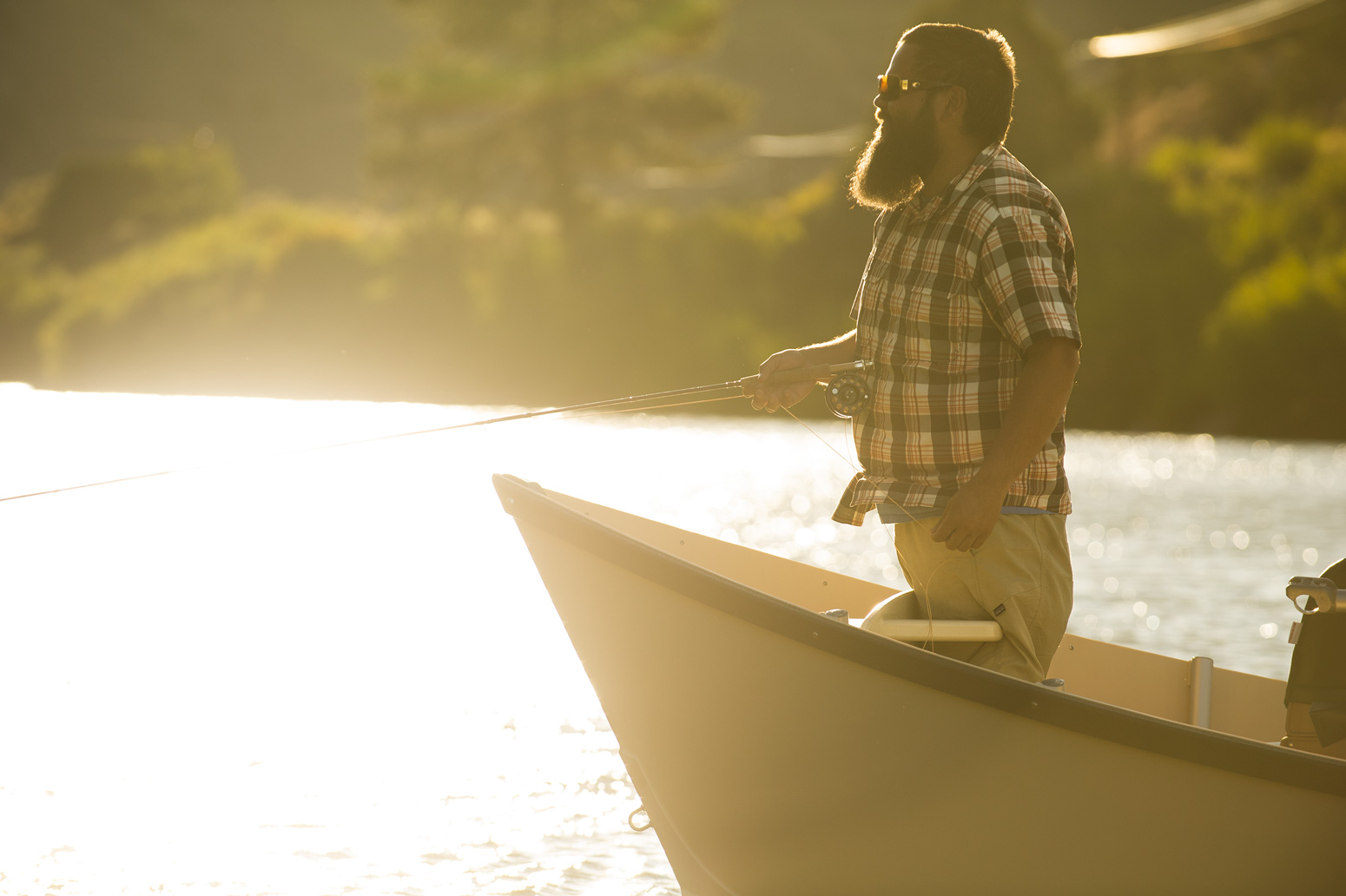
above Johnson makes his presence known on the bow of Andy Toohey’s boat on the upper Colorado River. This was supposed to be a one-day float, but in typical Johnson style it became a three-day marathon. Photo: Tim Romano
In 2012, one of Jay’s close friends committed suicide. Jay had recently been divorced and his friend Matt Schliske was going through a divorce too. These were wake-up calls. He asked himself about meaning in his own life, and realized that the work he was doing in flyfishing and helping other people discover flyfishing gave him purpose. So Jay and Schliske asked: How do we get more people into flyfishing? More importantly, how do we get people into flyfishing that wouldn’t otherwise be exposed to it? They posted a Craiglist ad in Fort Collins, CO, looking for the worst tattoo in town. They would pay to have the tattoo removed and get it tattooed on their own bodies if this person learned how to flyfish. That was the beginning of Pig Farm Ink.
Iron Fly started just before Pig Farm and evolved along the same path—it’s also about exposing people to flyfishing that might not encounter it otherwise. The event is set up at a bar, and the idea is for random patrons to come to a fly-tying table to see what’s going on with all the feathers strewn about. There are specific material-themed fly-tying contests inspired by Iron Chef. There’s off-hand tying, blindfolded tying and teaching a random person at the bar how to tie (the person teaching is not allowed to touch the fly themselves). If the person who tied the fly at the event caught a fish with it, they could win a pair of Costa sunglasses. What ultimately caused Iron Fly to catch on was a local newspaper article that claimed all the hot mountain men in town could be found at the event. This drew women, which brought even more dudes.
above Johnson locked in on rolling Yucatán tarpon. Photo: Justin Carfagnini
Get Trashed is another Pig Farm Ink project, a river cleanup/contest that awards points for fish caught, but awards more points for tires pulled from the river and bags of trash collected. Jay says the best Get Trashed event these days is on the upper Delaware River in Pennsylvania and New York. It’s been so successful that there’s almost not enough trash left in the river for another Get Trashed. The combo weekends usually include beer, barbecue and live music. Jay says, “It’s super-expensive, it’s a ton of work, and no one gets paid, but community is the greatest medicine we have.”
Jay wants to grow these events into a full-fledged carnival that includes a chili cook-off, barbecue contest and a primitive weapons contest (to include rock throwing, slingshots, atlatls and blowguns), and finishes with a beer-shotgunning competition. Jay happens to have a blowgun racked along the headliner of the Bajío bus that can be deployed easily from the driver’s seat.
Jay and Matt coined the hashtag #flyfishingsaveslives. As of September 2023, nearly 54,000 posts on Instagram are using the hashtag. Jay’s body is covered in a mosaic of decent and very bad tattoos. And lots of people are better off for having discovered flyfishing.
above Johnson rides high on a wild trash mustang after a weekend spent with Trout Unlimited Costa 5 Rivers college students at the 2019 Midwest Rendezvous in Readstown, WI. Photo: Justin Carfagnini
Music is playing constantly around Jay, both metaphorically and literally. His playlists are eclectic and good. They bounce back and forth between rundown tin-can honky tonk, bouncy calypso and the cerebral vibe of Del the Funky Homosapien. He’s listening to a lot of Anderson Paak and Bruno Mars these days. He’s proud of these two Asian Americans who made it big.
Soon after getting back to the states after 10 months of filming for Fish or Die, Jay got a phone call from his mom’s nurse, who said, “Your mom wants to see you. She’s dying.” Jay hadn’t seen his mom since he was a kid. He rushed to Fort Worth, TX, to be with her. When he told her what he had been doing, flyfishing around the world, she didn’t believe him. He had to leave her for a few days to attend the Fish or Die premiere. When he returned, he and his mom watched the first episode of the show together and Jay says it blew her mind.
Jay is 45 years old and thinking about the future. He maybe wants to get back to helping the Wind River Reservation in Wyoming develop a horse-packing/flyfishing outfitter for the locals to own and operate. He’s also working on buying some land on the Alaskan coast. He wants to cut and mill his own lumber and build a house, build furniture, live off of crabs, shoot a moose once a year and grow world-class vegetables in the long summer days. He’s shopping for a sailboat that’s big enough to sail across oceans so he can meet all the kids that were named after him in remote corners of the world. He says he’ll bring them the “things they really need, like machetes, pencils, paper, books, iPads and Coca-Cola.”
When that’s all done and the end finally comes, Jay wants Little Richard’s “Long Tall Sally” played during his funeral, right at the saddest part.
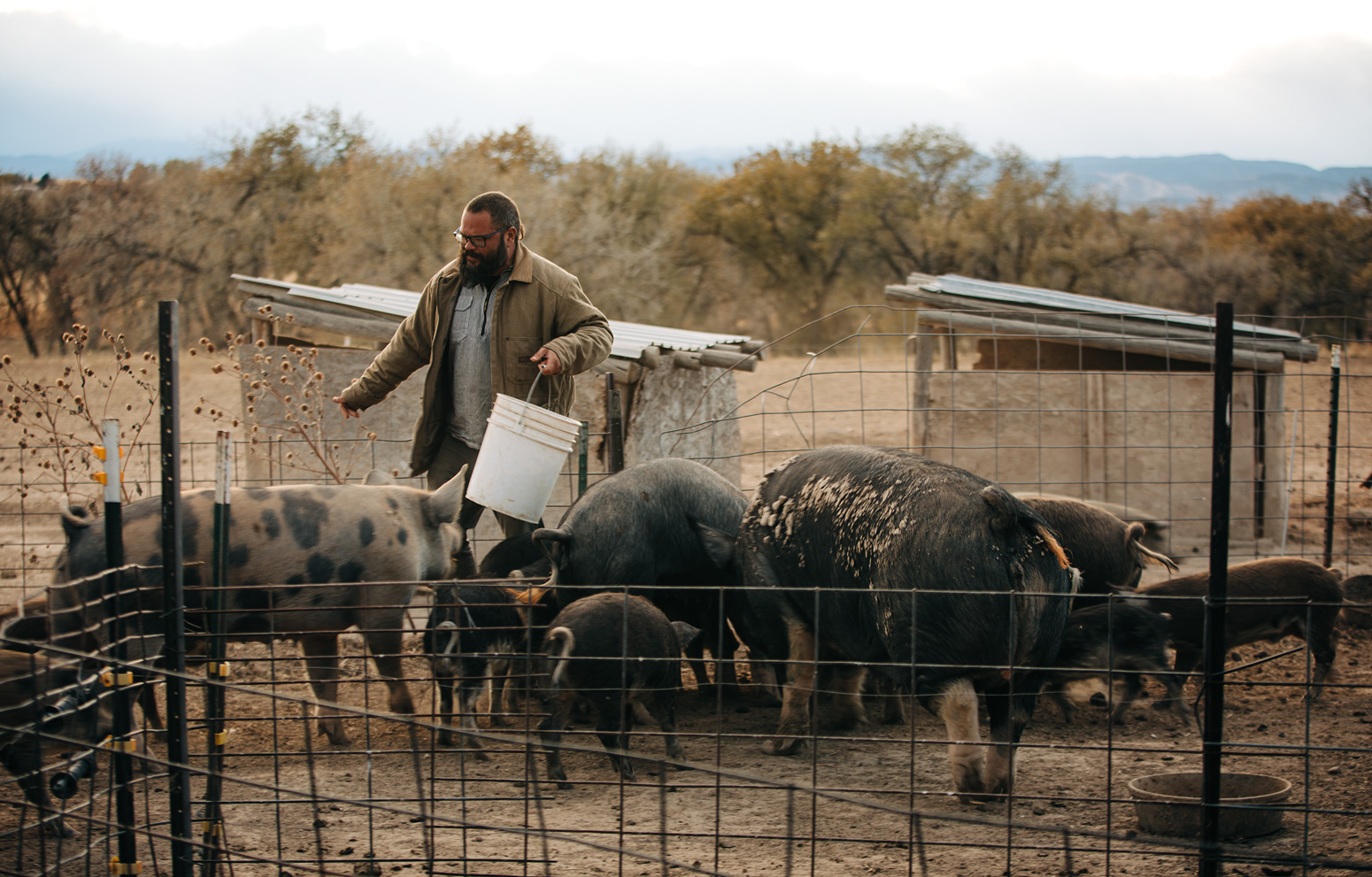
above Johnson does some real life pig farming on the Colorado Front Range, 2019. Photo: Justin Carfagnini
